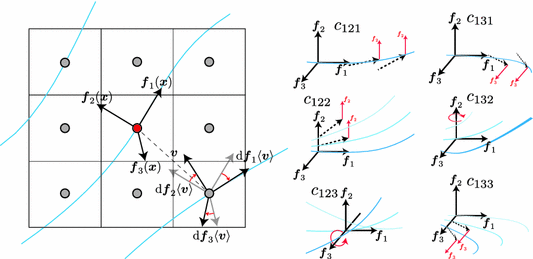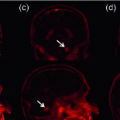m in diameter and 50–100  m in length. Their primary function is to produce mechanical tension during ejection, but certain specialized cells also serve to conduct electrical activation of the heart muscle. Cardiomyocytes are densely and smoothly packed within a three-dimensional extracellular matrix principally made of connective tissue. The term myofiber is often used as a proxy for localized parallel groups of cardiomyocytes, although they do not exist at a microscopic level. Histological and medical imaging studies have established certain key geometrical properties of cardiac myofibers: (1) they form a smoothly varying medium which wraps around each ventricle, (2) this wrapping generates the truncated ellipsoidal shape of the myocardium, (3) focusing on the LV, the helix angle, which is the angle of cardiomyocyte orientation taken with respect to the short-axis plane smoothly rotates from outer to inner wall by a total amount of approximately 120 degrees.
m in length. Their primary function is to produce mechanical tension during ejection, but certain specialized cells also serve to conduct electrical activation of the heart muscle. Cardiomyocytes are densely and smoothly packed within a three-dimensional extracellular matrix principally made of connective tissue. The term myofiber is often used as a proxy for localized parallel groups of cardiomyocytes, although they do not exist at a microscopic level. Histological and medical imaging studies have established certain key geometrical properties of cardiac myofibers: (1) they form a smoothly varying medium which wraps around each ventricle, (2) this wrapping generates the truncated ellipsoidal shape of the myocardium, (3) focusing on the LV, the helix angle, which is the angle of cardiomyocyte orientation taken with respect to the short-axis plane smoothly rotates from outer to inner wall by a total amount of approximately 120 degrees.
3 Moving Frames in 
 be expressed in terms of
be expressed in terms of  , the natural basis for
, the natural basis for  . We define a right-handed orthonormal frame field
. We define a right-handed orthonormal frame field  . Each frame axis can be expressed by the rigid rotation
. Each frame axis can be expressed by the rigid rotation  , where
, where  is a differentiable attitude matrix such that
is a differentiable attitude matrix such that  . Treating
. Treating  and
and  as symbols, we can write [6]
as symbols, we can write [6]
 is constant, the differential geometry of the frame field is completely characterized by
is constant, the differential geometry of the frame field is completely characterized by  . Taking the exterior derivative on both sides, we have
. Taking the exterior derivative on both sides, we have
 denotes the exterior derivative, and
denotes the exterior derivative, and  is the Maurer-Cartan matrix of connection forms
is the Maurer-Cartan matrix of connection forms  . Writing
. Writing  as symbols, (2) is to be understood as
as symbols, (2) is to be understood as  . The Maurer-Cartan matrix is skew symmetric [6], hence we have
. The Maurer-Cartan matrix is skew symmetric [6], hence we have
 ,
,  , and
, and  . 1-forms operate on tangent vectors through a process denoted contraction, written as
. 1-forms operate on tangent vectors through a process denoted contraction, written as  for a general 1-form
for a general 1-form  and tangent vector
and tangent vector  on
on  , which yields
, which yields  , since
, since  , where
, where  is the Kronecker delta.
is the Kronecker delta. . This space can be explored by considering the motion of
. This space can be explored by considering the motion of  in a direction
in a direction  , using the first order terms of a Taylor series centered at
, using the first order terms of a Taylor series centered at  :
:
 and
and  are evaluated at
are evaluated at  , and
, and  are the connection forms of the local frame. Since only 3 unique non-zero combinations of
are the connection forms of the local frame. Since only 3 unique non-zero combinations of  are possible, there are in total 9 connections
are possible, there are in total 9 connections  . These coefficients express the rate of turn of the frame vector
. These coefficients express the rate of turn of the frame vector  towards
towards  when
when  moves in the direction
moves in the direction  . Figure 1 illustrates the behavior of the frame field described by
. Figure 1 illustrates the behavior of the frame field described by  . For example, with
. For example, with  taken to be the local orientation of a fiber and
taken to be the local orientation of a fiber and  taken to be the component of the heart wall normal orthogonal to
taken to be the component of the heart wall normal orthogonal to  ,
,  measures the circumferential curvature of a fiber and
measures the circumferential curvature of a fiber and  measures the change in its helix angle [9].
measures the change in its helix angle [9].
 expressed in the local basis
expressed in the local basis  when
when  moves in the direction
moves in the direction  . (Right) frame field variation characterized by the connections
. (Right) frame field variation characterized by the connections  for
for  (
( are not shown).
are not shown).4 Computation of Connection Forms
 . We shall explore three ways of computing these: (1) a direct estimate based on finite differences, (2) a regularized optimization scheme, and (3) a novel closed-form computation which yields exact results on linear manifolds. In Sect. 4.4 we discuss conditions under which each method could be used, and later in Sect. 5 we use various combinations of these for inpainting 3D frame fields.
. We shall explore three ways of computing these: (1) a direct estimate based on finite differences, (2) a regularized optimization scheme, and (3) a novel closed-form computation which yields exact results on linear manifolds. In Sect. 4.4 we discuss conditions under which each method could be used, and later in Sect. 5 we use various combinations of these for inpainting 3D frame fields.4.1 Connections via Finite Differentiation
 can be directly obtained using (2), i.e.,
can be directly obtained using (2), i.e.,  The differentials
The differentials  can be computed by applying the exterior derivative for a function, i.e., for the k’th component of
can be computed by applying the exterior derivative for a function, i.e., for the k’th component of  ,
,  ,
,  ,
,
![$$\mathbf {J}_i=\left[ \frac{\partial {\varvec{f}}_{ip}}{\partial x_q}\right] \in \mathbf {R}^{3\times 3}$$](/wp-content/uploads/2016/09/A339424_1_En_41_Chapter_IEq64.gif) is the Jacobian matrix of partial derivatives of
is the Jacobian matrix of partial derivatives of  . Setting
. Setting  , we obtain
, we obtain
 can be approximated to first order using, e.g., finite differences on
can be approximated to first order using, e.g., finite differences on  with a spacing of size
with a spacing of size  :
:  .
.4.2 Connections via Energy Minimization
 at a point
at a point  can also be obtained as the minimizer of an extrapolation energy
can also be obtained as the minimizer of an extrapolation energy  contained within a neighborhood
contained within a neighborhood  :
:
 is a regularization weight used to penalize high curvature. Denoting
is a regularization weight used to penalize high curvature. Denoting  as the normalized approximation to
as the normalized approximation to  at
at  using (4), we follow [8] and choose
using (4), we follow [8] and choose  to minimize the angular error between
to minimize the angular error between  and
and  :
:  , with
, with  .
.4.3 Closed-Form Connections in Linear Space
 is not explicitly enforced, i.e., the requirement that
is not explicitly enforced, i.e., the requirement that  . Thus it may lead to non-integrable differential descriptors. We now develop a novel way of computing connection forms that is based on trigonometrical considerations in the first-order structure of 3D frame fields and which enforces that coupling. This method also provides exact
. Thus it may lead to non-integrable differential descriptors. We now develop a novel way of computing connection forms that is based on trigonometrical considerations in the first-order structure of 3D frame fields and which enforces that coupling. This method also provides exact  measurements in manifolds that have low second-order curvatures (
measurements in manifolds that have low second-order curvatures ( ). Given a local basis
). Given a local basis  and data-driven neighboring bases
and data-driven neighboring bases  , the 1-forms
, the 1-forms  can be solved for using linear least-squares. We begin by expanding (4),
can be solved for using linear least-squares. We begin by expanding (4),
 denote the projection of
denote the projection of  in the
in the  –
– plane, i.e.,
plane, i.e.,  and let
and let  denote the signed angle between
denote the signed angle between  and
and  with positive values assigned to
with positive values assigned to  rotating
rotating  towards
towards  , obtained as
, obtained as





